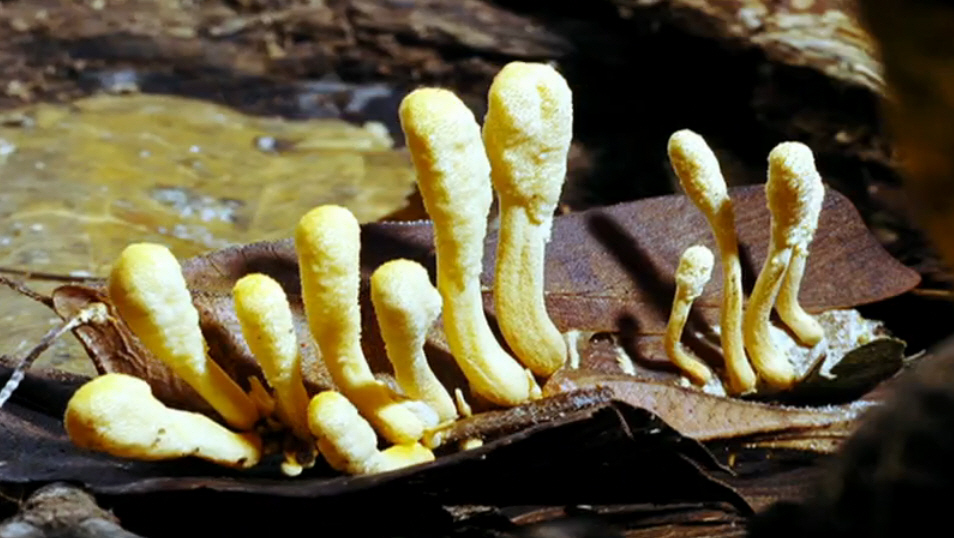Cordyceps can inhibit cancer cell growth
Dr Cornelia de Moor

And we’re only just beginning to explore the implications of some of these. We don’t yet fully understand why some fungi have such a potent effect on us. More research is needed. But, already, we’re beginning to exploit some of their seemingly sinister behaviour for our own benefit.
Can I introduce you to cordyceps?
These are dried specimens of a very famous fungus, famous in Chinese medicine for curing all manner of ills. It’s a curious fungus with a strange, parasitic lifestyle. Unlike most fungi, it doesn’t feed on dead matter but instead seeks out a very different host.
Like something out of science fiction, this fungus grows inside insects, slowly killing them until the fruiting body is ready to emerge. But despite its rather, alien life habits, the chemicals concealed inside the cordyceps may yet prove crucial to a major medical breakthrough.
Doctor Cornelia de Moor from the University of Nottingham is using this little mushroom in a cutting-edge treatment for one of our most feared diseases – cancer.
Dr Cornelia de Moor “So in cordyceps there are very high levels of this cordycepin. And cordycepin is a compound that is actually only very slightly changed from a very common compound that you find in all cells called adenosine. It’s only one oxygen difference. But for some reason, only cordyceps fungi make cordycepin while all organisms make adenosine.”
This unique compound produced by cordyceps has long been of interest to alternative medicine in the treatment of cancerous tumours. But how it works was never clear and Cornelia was keen to find out.
Cornelia de Moor “What surprised us immensely the first time we treated cells with cordycepin is when we put cordycepin on cells like that, they changed shape into cells like that in which the little grains are gone and the cells start to shrink. So when we saw this, we knew there was something quite fundamental happening to the cells and that then led to our later discoveries on the effects of cordycepin.”
Cornelia knew that with any cancer, in order for the individual cells to multiply and grow, they must join themselves together using tiny stems called poly-A tails. And it’s here that she has discovered that cordycepin plays a crucial role.
Dr Cornelia de Moor “So we’ve been doing some work on breast cancer cells, which we’ve been treating with cordycepin, and what we’re seeing is that the cordycepin appears to stop the making of the long poly-A tail. So it might not kill the cell but the most important thing – it stops the growth of the cancer cell, by cutting off the machinery that is necessary for cell growth. It is a completely new mechanism for a cancer drug, so all other cancer drugs work on completely different principles, not on inhibiting this polydenylation, so it could be the first of a new class of drugs, not only for cancer, but also for inflammatory disease.”
Medical breakthroughs, from Fleming’s penicillin to cutting-edge cancer research, reveal an extraordinary truth. The cells of fungi have the ability to interact with our own cells on a profound level… to alter them in ways that affect our health, even our survival. This is a powerful clue to the true relationship between fungi and us.
Time and again, we seem to discover deep biological connections between ourselves and the fungi. But what could we have in common with a mushroom? To find out the answer, we have to delve deep into our own evolutionary history.
As we’ve seen, fungi are neither plant nor animal. Early in the story of life on Earth, they established themselves as a kingdom in their own right. But it’s the moment when this happened that is truly significant. At the point when plants and animals diverged, the fungi were still part of that animal branch. It was not until about ten million years later that they began their own evolutionary journey as a distinct kingdom. This explains why they have retained a number of key biological traits that make them much more animal than plant, much more like us. Traits we’ve seen time and time again, as we’ve explored their fascinating life cycle… from the explosive way that they release their spores… to the way they feed and digest other organisms, much as we do.
At every stage of their life, fungi reveal just how much like us they are. It’s a powerful connection, that explains why we work so well together. So we are all much more mushroom than you could ever imagine.
And because of this close affinity, sometimes the fungi work with us, and even sometimes against us… and that is the true magic of mushrooms.
